Top News
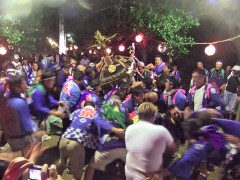
October 6, 2013 Junko Uechi correspondent of Ryukyu Shimpo
Kitadaito Island celebrated the annual festival Daitogusai on September 22 and 23 to pray for bumper crops. The Daitogu Shrine has honored Amaterasu Omikami, the goddess of the sun, as the guardian deity for people on the island since its early days. The villagers hold the festival every year. It is a unique event with a fusion of the traditions of Okinawa and the main islands of Japan, including rituals, a portable shrine tour, sumo dedication and entertainment.
On September 22, a mikoshi portable shrine parade was held by three groups – adults, junior high school and elementary school pupils. After starting from the shrine, they visited the sugar factory, the branch office of the JA Okinawa, and the municipal office, while in the background the bell and drum resounded from the festival float. On September 23, the sumo dedication was held at the shrine.
Children from kindergartens, pupils from the elementary school and junior high school took part in the event. The residents encouraged their children who were doing their best at sumo, including trying to defeat three and five opponents in a row. Local players and those from Kume-jima Island took part in the Okinawa sumo and Edo (Japanese) sumo and the people in the audience were excited watching the bouts.
(English translation by T&CT, Mark Ealey)
Go to Japanese

October 4, 2013 Ryukyu Shimpo
Restoration work on four facilities at Shuri Castle such as the Kuganiudun, meaning the golden palace, including the King’s bedroom, has entered the final stage. On October 2, a Ryukyu Shimpo photographer took an aerial photograph confirm that craftsmen were fixing about 40,000 roofing tiles. The facilities will be completed by the end March 2014 at the earliest. Shuri Castle is designated as a World Heritage Site.
According to the Okinawa Commemorative National Government Park Office, the four facilities are the Kuganiudun, including the King’s living room and bedroom, the Oku Shoin (inner drawing room) where the King rested, the Yunchi (kitchen) and the Kinjutsumesho or the rooms for about 20 attendants to the King. Once the construction is completed, the Seiden (State Hall) and Nanden (South Hall) at Shuri Castle will connect with the building. Visitors will be able to get a feel of the routine of the king in the castle.
(English translation by T&CT, Mark Ealey)
Go to Japanese

October 6, 2013 Ryukyu Shimpo
Latin singer Yuki Taira sings songs in the Okinawan dialect. On October 3, Taira held a concert at the community hall in Ada, Kunigami, where she graduated from elementary and junior high schools.
Ada Elementary School held the concert as part of career education. This was the first concert held in Ada. About 70 people, including pupils from the school, Aha Elememtary school and local residents took part.
Taira said to the pupils, “It is a win in life if you make your dreams come true. You can do it if you don’t give up.”
Taira talked about her life as a singer, telling the audience that she decided to become a singer when she was 29 years old. Taira performed in Osaka and Tokyo for 15 years and when she was 49 years old, she moved to Cuba, where she studied latin music at music college for a year. She said, “People will surely support you If you can see how to make your dreams come true.”
After her talk session, Taira sang a tribute to her hometown Kunigami in what is known as Son cubano, a style of music originating in Cuba. She also sang Iju nu Hana. At the end of the concert, Taira amused the audience by performing a kachashi song arranged to Latin music.
Five-year-old Takuma Higa of Ada Elementary School said, “I was carried away by Taira’s performance. It was just great.” Ada Elementary School principal Gakuji Goto, who planned the concert, said, “Yuki Taira said that you can make your dreams come true at any age if you continue to have dreams. This impressed me. The concert was stimulating for the pupils.”
(English translation by T&CT, Mark Ealey)
Go to Japanese
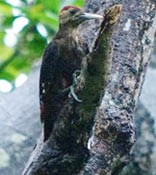
October 1, 2013 Ryukyu Shimpo
A male noguchigera Okinawa woodpecker was confirmed as having been seen in Nago-dake in Nago in the morning of September 28. This sighting is the first time in over four years. The noguchigera is designated as a special national treasure and is an endangered species that inhabits part of an area in Ogimi and Kunigami Village. It is extremely rare for there to be a sighting of the bird in Nago. Masakuni Yamashiro, the chairman of the Wild Bird Society of Okinawa said, “We hope that the natural distribution range of the noguchigera is expanding. This bird symbolizes the rich nature of Okinawa.”
On September 28, Yutaka Toguchi, a warden of the Yagaji national wildlife protection, confirmed the sightseeing of the bird. He heard the sound of the woodpecker pecking on a tree and then the bird appeared. He has received information that residents have seen the woodpecker since August.
In the Red Data Book by the Ministry of the Environment, the noguchigera is listed as endangered 1A class, which means that it has a very high risk of extinction in the immediate future. According to Toguchi, until 1980 there were sightings of the bird at Tano-dake in Nago. The warden is observing the bird in Nago-dake in cooperation with Nago Museum.
Please send information of sightings of noguchigera to the Nago Museum. Telephone: 0980 (53) 1342.
(English translation by T&CT, Mark Ealey)
Go to Japanese
October 4, 2014 Ryukyu Shimpo
With the U.S. Secretaries of State and Defense and Japan’s Ministers for Foreign Affairs and of Defense in attendance, the U.S.-Japan Security Consultative Committee, otherwise known as the “two-plus-two” security meeting, has convened in Tokyo. Japan and the United States agreed to increase the level of MV-22 Osprey training outside Okinawa and Japan.
The transfer of Osprey training outside of Japan does not fundamentally resolve the issues that the Okinawan people face. Removal of all Osprey aircraft from Okinawa is the only solution.
The U.S. military insists that when viewed in terms of the low number of Class A category mishaps the Osprey is the safest aircraft around. However, Class A Mishap accidents involving the Osprey happened in June and August and this aircraft also made an emergency landing in September. In the same month, an Osprey had a problem with its landing gear at U.S. Marine Corps Air Station Futenma. So surely it is anything but the safest aircraft.
While the Japanese government asserts that deploying the aircraft in Okinawa enhances deterrence, the Osprey is a transport aircraft and is not capable of protecting Japan from attack. This aircraft is noisy and is a threat to the safety of the Okinawan people.
The U.S. military does not adhere to the agreement put in place in the U.S.-Japan Joint Committee. Both governments banned Osprey flight training after 10:00 p.m., but the military continue to fly the aircraft long past this time. As long as the Osprey are in Okinawa, there is no fundamental resolution to the problem.
The security meeting did not give the details on the transfer of Osprey training.
The Japanese government will need to discuss the transfer with the heads of municipalities where the Osprey training could take place and the plan to transfer the training may come to nothing if these governments oppose it.
The committee states, “As an essential element of this effort, the Ministers confirmed that the plan to construct the Futenma Replacement Facility (FRF) at Camp Schwab-Henokosaki area and adjacent waters is the only solution that addresses operational, political, financial, and strategic concerns and avoids the continued use of Marine Corps Air Station (MCAS) Futenma.”
We have difficulty understanding how the plan resolves financial concerns. To move the facilities at Futenma to existing military installations outside Okinawa or Japan is far cheaper than what is proposed in the plan.
The political concerns mentioned in the statement remind us of what former Defense Minister Satoshi Morimoto said: “The Japanese government will move the base within Okinawa for political not strategic reasons.”
To us, the U.S. and Japanese governments saying in the official statement that the military will move the base to Henoko is because the Japanese government does not want to move it to other areas of Japan for political reasons. If this is the case, then both governments are clearly discriminating against Okinawa.
The U.S. and Japanese governments also agreed that from the end of December the Lockheed P-3 Orion aircraft at Kadena Air Base will be replaced by the Boeing P-8 Poseidon.
While both governments pretend to reduce the burden of bases on Okinawa by transferring the Osprey training outside of the prefecture, they then reinforce the bases in Okinawa with new military aircraft. We will not tolerate such an agreement.
We demand that the U.S. and Japanese governments remove all of the Osprey aircraft from Okinawa, and seek the early closure of the base and the return of the land that it uses. We also demand that both governments cancel bringing the P-8 Poseidon aircraft to Okinawa.
(English translation by T&CT, Mark Ealey)
Go to Japanese
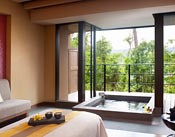
September 27, 2013 Ryukyu Shimpo
The Ritz-Carlton Spa by ESPA took first prize in the Crystal Awards 2013. The awards are given to spas in Japan, which are chosen by the customers. This event, which is the only exhibition specializing in the spa and wellness business in Japan, aims to help establish the Japanese style spa. The Ritz-Carlton Spa by ESPA won the award for Excellence in Treatment Techniques, Facilities, Hospitality and Customer Service.
The Okinawa Beach Resort Ocean Spa Kariyushi in Onna was named among the top 10 winners.
The Hyakuna Garan in Nanjo won the Design Section Award, which is chosen by people in the business. The Innovation Award was given to the Okinawa Prefectural Esthetic Spa Association in Naha. The award ceremony was held at Spa & Wellness Japan 2013 at Tokyo Big Site on September 9.
(English translation by T&CT, Hitomi Shinzato and Mark Ealey)
Go to Japanese

September 26, 2013 Ryukyu Shimpo
The rice paper butterfly characterized by its black and white patchy pattern is the largest butterfly in Japan. Its black color variety was found on September 25. It is very rare to see such a butterfly.
The butterfly has wings that are more than 90 percent black.
Doctor of Agriculture Yasuhiro Oshiro, the head of the Fly Butterflies Around Shurijo Castle Association, said, “All of the rice paper butterflies that we have found so far have wings that are about 60 percent black. This new butterfly is one in 200,000 to 300,000. There is no doubt that it is a new breed.”
Oshiro heard about the newly found butterfly from one of his friends. It is a female, which emerged from a pupa on September 24. The pupa itself is no different from those of regular rice paper butterflies. Oshiro said, “I have been involved the study of insects for 50 years and have raised between 20,000 and 30,000 rice paper butterflies. This is the first time that I have seen such a black one. I have never seen one of these at the Garden of Manko Lake where more than 100,000 butterflies have been raised.”
(English translation by T&CT, Mark Ealey)
Go to Japanese
September 27, 2013 Ryukyu Shimpo
The Okinawa Prefectural Assembly began questioning the Okinawa Prefectural Government on September 26 for the September round of regular meetings. Four people asked questions on the first day. Governor Hirokazu Nakaima stated that he will decide in December or beyond whether or not to grant approval of the application documents to reclaim land off Henoko in Nago. Nakaima said, “It will be a decision that fits in with the context of previous statements.” The Okinawa Defense Bureau has filed the application to the governor for permission to carry out the reclamation necessary to build a replacement base for U.S. Marine Corps Air Station Futenma.
To date, the governor has repeatedly stated that moving the base to Henoko would be difficult and that it should be relocated outside Okinawa. This new statement has caused ripples in that it implies a rejection of the base relocation plan.
Governor Nakaima also voiced doubts from the viewpoint of feasibility, saying that the plan is “a pie in the sky, just a plan on paper.” He made this comment in response to a member of the Social Democratic Party and Okinawa Goken-network (a parliamentary group for Protecting the Constitution) Yoshiaki Nitta.
In the past, the governor has limited his comments on deciding whether or not to adopt the plan to saying that he will take everything into account. This is the first time that he has suggested what his decision might be. After the session, Nakamine answered a question from a reporter seeking to confirm that what he said reflects his past stance of requiring that the U.S. military base be moved outside of Okinawa. He said, “I have no idea. I am in the process of reading the application document and I have not taken any specific steps yet, so I answered the question in general terms.”
In the second questioning session, a member of the Liberal Democratic Party, Isho Urasaki, asked the governor, “If there are no problems at all with the application documents, will that affect the judgment? In the 17 years since the issue of moving Futenma began, all sorts of political problems have arisen. Will they also affect the judgment?” Governor Nakaima said that it goes without saying that the decision will be made from a political perspective.” He stated that the judgment would be in keeping with the context of his previous statements.
He also pointed out problems with the plan, saying, “It has made no progress in the past ten or so years.” Nakaima said, “Judgments on the practical and technical levels on both the Japanese and American sides are impacting upon the politics. I think the U.S. and Japanese governments should settle the issue politically.”
(English translation by T&CT, Lima Tokumori and Mark Ealey)
Go to Japanese
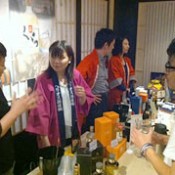
September 29, 2013 Ryukyu Shimpo
The Seoul office of the Japan External Trade Organization held a seminar event at Gangnam Finance Center in Seoul on September 24 to introduce the Okinawan alcoholic beverage awamori to local hotels and izakaya or Japanese style taverns. A total of 16 South Korean buyers attended the event.
Helios Brewery took part from Okinawa, introducing the drink and holding a tasting session. The company will officially ship the awamori brand Kura to South Korea from the beginning of October.
Akane Matsuda of Helios Brewery explained the best ways to drink awamori, introducing five brands, including plum wine. The event was popular among the buyers. One of them said, “I am glad to learn the diverse nature of the drink.” Another buyer said, “Awamori could make inroads into the alcoholic drink market in South Korea if the companies appeal to customers by selling it as a premium shochu, which is already popular here.”
Matsuda said, “By talking directly to the people involved in hotels and izakaya, I was able to get more information about distribution, marketing channels and price setting. I think we got a toehold for developing the awamori market in South Korea.”
(English translation by T&CT, Mark Ealey)
Go to Japanese
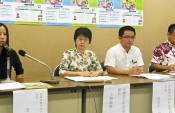
September 25, 2013 Ryukyu Shimpo
From September 28 at the Peace Memorial Museum in Itoman City, the Okinawa Prefectural Government will screen a documentary film featuring 350 Battle of Okinawa survivor testimonies.
To mark the film release, on September 28 a symposium was held with Professor Shinobu Yoshihama of Okinawa International University as guest speaker. The theme of the symposium was how to pass down lessons from the Battle of Okinawa to the next generation. Four days earlier, on September 24, Curator Miwako Ueyonabara of the museum and Director of the World Youth Uchinanchu Association Minami Tamamoto held a press conference at the prefectural government building. They called for many people to come to the museum to see the documentary.
The documentary film features 300 stories that survivors told their family members in a government project conducted in fiscal 2012. At the end of the year the government will release a further 50 stories from Hawaii and the Pacific Islands that the museum has edited. The museum has now collected and released a total of 600 testimonies. Referring to the large-scale publication of 350 testimonies, Ueyonahara stressed the need to pass down lessons learned from history to the next generation.
Tamamoto, one of panelists at the symposium with Professor Yoshihama and survivor Kojun Yokota, suggested using Shimakutuba or the Okinawan language as a new way to pass on the stories. She said, “We have only heard stories of the war told in Japanese. Some of the survivors have said they could tell their stories better in Shimakutuba. I would like to see a discussion of the war linked with the succession of language.”
As related events, from October the government will hold debriefing sessions on the neighboring islands and in the central and northern parts of Okinawa. For further details, call the project office at 098 (862) 0012.
(English translation by T&CT, Megumi Chibana and Mark Ealey)
Go to Japanese
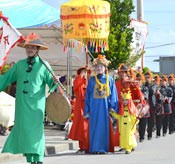
A full moon festival was held in the square in front of the Tomimori Community Center in Yaese on September 22. The town’s intangible cultural heritage parades: Tunchu junei (Chinese), Yamatonchu junei (Japanese) and Yonshi (women’s) were held. The parades depicted colorful and spectacular scenes seen on historical picture scrolls. It is said that Tunchu junei was introduced into Tomimori by Chinese people living in Kume-son, Naha during the Ryukyu Kingdom era. An elderly nobleman called an au leads the parade, holding a triangular flag to the high-pitched sound of an instrument called a gaku in China. They gave a karate demonstration dressed in black costumes in front of the king wearing a crown.
The Yamatonchu junei is thought to have developed from the daimyo procession seen by the delegations sent to Edo from the Kingdom of Ryukyu. The participants marched dressed in samurai costumes, holding guns, swords and lanterns. The parade advanced with people calling out “shitani, shitani” meaning “bow down your heads.”
The traditional arts were performed on a special stage in the evening to deepen friendships in the community.
(English translation by T&CT, Mark Ealey)
Go to Japanese









 Webcam(Kokusai Street)
Webcam(Kokusai Street)


